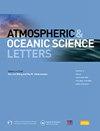Long-term variations of the solar energy in different subregions of Northwest China and associated mechanisms
IF 3.2
4区 地球科学
Q3 METEOROLOGY & ATMOSPHERIC SCIENCES
引用次数: 0
Abstract
As a type of clean and pollution-free energy source, solar energy plays an important role in achieving the goals of carbon neutrality and global sustainable development. Northwest China occupies an important position in the national energy strategy due to its rich solar energy. Clarifying the long-term variations of Northwest China's solar energy and understanding the associated mechanisms are crucial to improving the layout of new energy sources and the usage efficiency of solar energy within China. In this study, the authors first divide Northwest China into northwestern and southeastern sections by conducting a rotated empirical orthogonal function analysis on the surface solar radiation (SSR) from 1993 to 2022, and then explore the SSR's variation trends and associated mechanisms within these subregions. It is found that the two subregions, both of which show a significant feature of decadal change, differ notably in their long-term trends: the northwestern section shows a significant increasing trend of ∼8.1 kJ m−2 yr−1 in the annual mean SSR, and in each season the SSR increases significantly, with a maximum/minimum increasing rate of ∼11.2/∼4.6 kJ m−2 yr−1 appearing in summer/autumn. A possible mechanism for the SSR's increasing trend is that global warming results in a lower relative humidity within the northwestern section, which decreases the total cloud cover, as it is harder for the atmosphere to reach saturation state. A decreasing total cloud cover results in an increasing SSR within the northwestern section. In contrast, the southeastern section shows no significant trend in annual mean SSR, as the SSRs in summer and autumn show significant decreasing trends, whereas the trends in spring and winter are not significant.
摘要
作为一种清洁无污染的新能源, 太阳能对于实现碳中和及可持续发展的目标至关重要. 西北地区太阳能资源丰富, 在我国能源战略中占据着重要地位. 厘清西北地区太阳能的长期变化趋势并揭示其可能的内在机理有助于改善我国的新能源布局并提高太阳能的利用效率. 鉴于此, 作者首先对1993年至2022年的地表太阳辐射 (SSR) 进行了旋转经验正交函数分析, 将西北地区划分为西北和东南两个分区, 然后分别研究了这些分区内SSR的变化趋势和相关机制. 研究发现, 在西北地区的两个分区内, SSR均表现出显著的年代际变化特征, 但两个分区内的SSR趋势存在显著不同. 对于西北分区而言, 其年平均SSR呈现出显著的增长趋势 (增速约为8.1 kJ m−2 yr−1), 在每个季节, 其季节平均的SSR都显著增加, 最大与最小增速分别为11.2 (夏季) 和4.6 kJ m−2 yr−1 (秋季). 该区域内SSR增加趋势的一个可能机制是, 全球变暖导致该区域内相对湿度较低, 所以大气更难达到饱和状态, 这直接导致该区域内的总云量减少; 总云量的减少使得云对太阳短波辐射的反射, 散射和吸收减弱, 因此, 该区域内SSR增加. 对于东南分区而言, 由于其夏季和秋季的SSR呈显著的下降趋势, 而春季和冬季的SSR趋势并不显著, 所以该区域内年平均的SSR没有显著的线性趋势.
中国西北不同次区域太阳能的长期变化及相关机制
太阳能作为一种清洁无污染的能源,在实现碳中和和全球可持续发展的目标中发挥着重要作用。西北地区太阳能资源丰富,在国家能源战略中占有重要地位。厘清西北地区太阳能的长期变化规律及其机制,对优化新能源布局和提高太阳能利用效率具有重要意义。本文首先通过对1993 - 2022年中国西北地区地表太阳辐射(SSR)的旋转经验正交函数分析,将西北地区划分为西北和东南两个区域,并探讨了这两个区域内的SSR变化趋势及其相关机制。结果表明,两亚区均表现出显著的年代际变化特征,但其长期趋势存在显著差异:西北段的年平均SSR显著增加,为~ 8.1 kJ m−2 yr−1,且各季节SSR显著增加,最大/最小增幅为~ 11.2/ ~ 4.6 kJ m−2 yr−1,出现在夏季/秋季。SSR增加的可能机制是全球变暖导致西北段相对湿度降低,使总云量减少,使大气较难达到饱和状态。总云量减少导致西北剖面SSR增加。东南段的年平均SSR变化趋势不显著,夏季和秋季的SSR变化趋势显著,而春季和冬季的SSR变化趋势不显著。摘要作为一种清洁无污染的新能源, 太阳能对于实现碳中和及可持续发展的目标至关重要. 西北地区太阳能资源丰富, 在我国能源战略中占据着重要地位. 厘清西北地区太阳能的长期变化趋势并揭示其可能的内在机理有助于改善我国的新能源布局并提高太阳能的利用效率. 鉴于此,作者首先对1993年至2022年的地表太阳辐射(SSR)进行了旋转经验正交函数分析,将西北地区划分为西北和东南两个分区,然后分别研究了这些分区内SSR的变化趋势和相关机制。研究发现,在西北地区的两个分区内,SSR均表现出显著的年代际变化特征,但两个分区内的SSR趋势存在显著不同。对于西北分区而言,其年平均SSR呈现出显著的增长趋势(增速约为8.1 kJ m−2年−1),在每个季节,其季节平均的SSR都显著增加,最大与最小增速分别为11.2(夏季)和4.6 kJ m−2年−1(秋季)。该区域内SSR增加趋势的一个可能机制是,全球变暖导致该区域内相对湿度较低,所以大气更难达到饱和状态,这直接导致该区域内的总云量减少;。对于东南分区而言,由于其夏季和秋季的SSR呈显著的下降趋势,而春季和冬季的SSR趋势并不显著,所以该区域内年平均的SSR没有显著的线性趋势。
本文章由计算机程序翻译,如有差异,请以英文原文为准。
求助全文
约1分钟内获得全文
求助全文
来源期刊

Atmospheric and Oceanic Science Letters
METEOROLOGY & ATMOSPHERIC SCIENCES-
CiteScore
4.20
自引率
8.70%
发文量
925
审稿时长
12 weeks
 求助内容:
求助内容: 应助结果提醒方式:
应助结果提醒方式:


